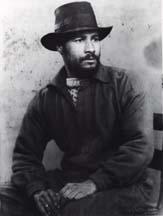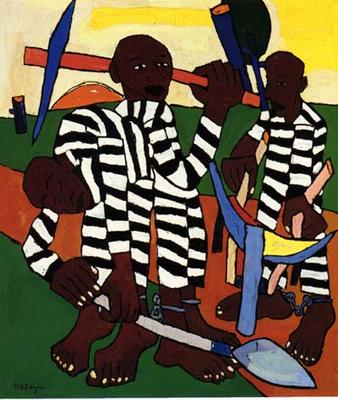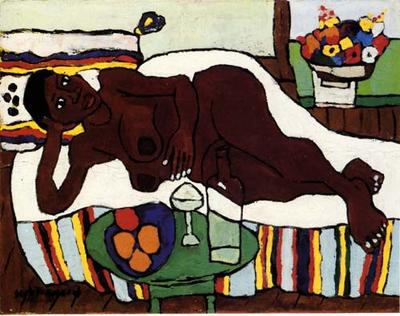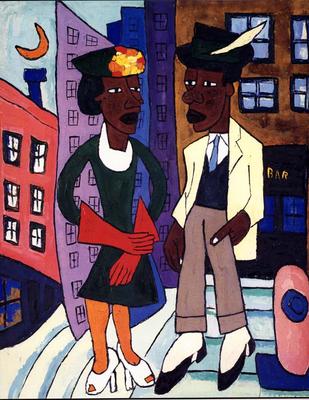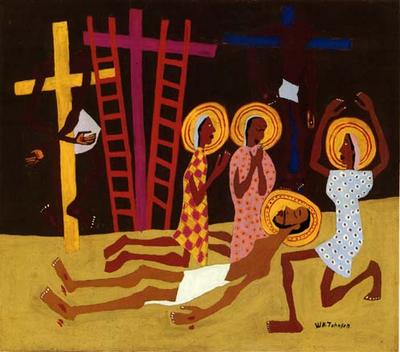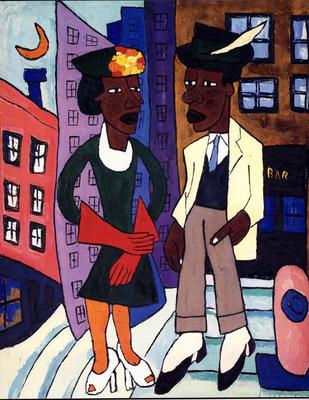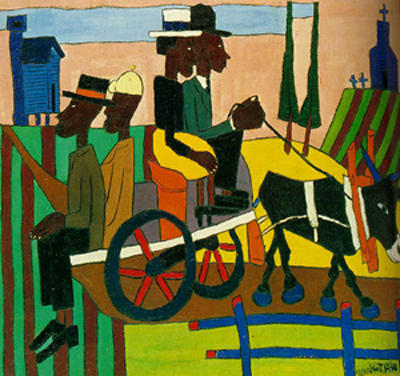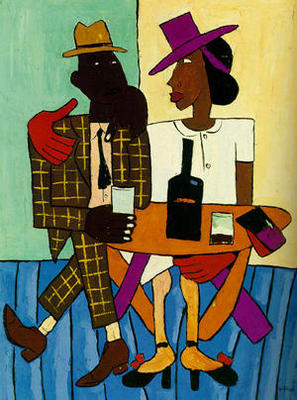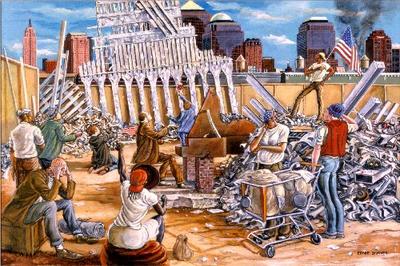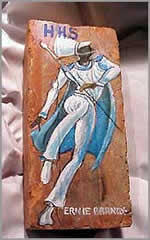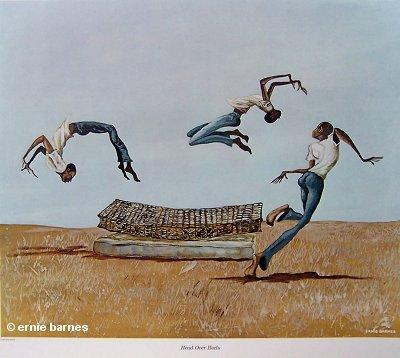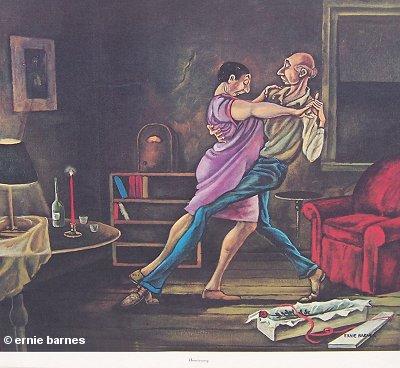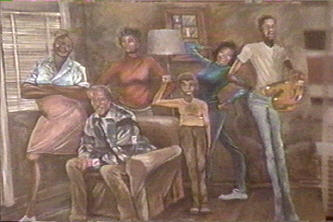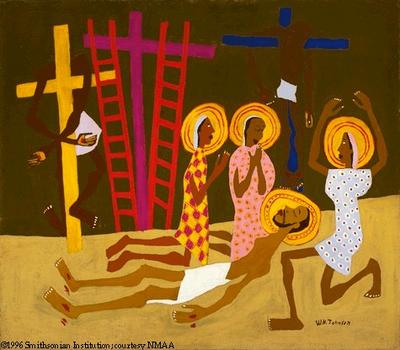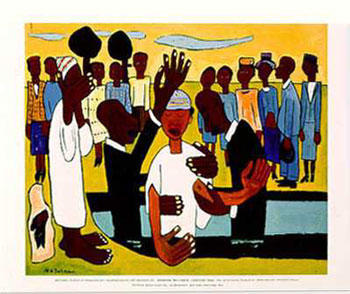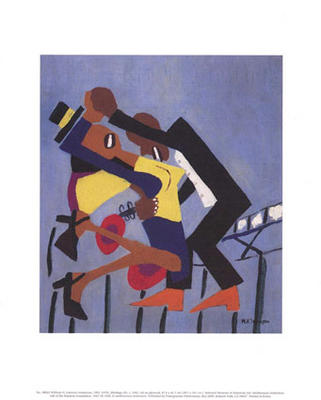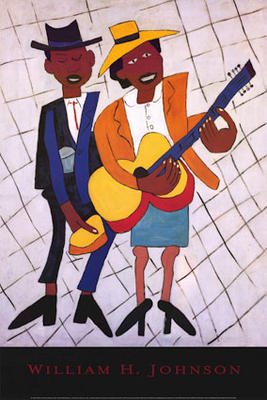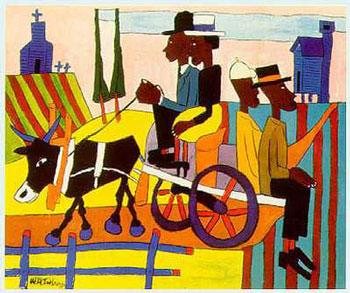Sunday, December 24, 2006
Friday, November 11, 2005
Sunday, October 30, 2005

PRIMARY WORKS, Gwendolyn B. Bennett
Publications in Anthologies and Books:
"Nocturn," in The Book of American Negro Poetry, edited by James Weldon Johnson. New York: Harcourt, Brace, 1922; revised, 1931.
"Moon Tonight" and "Song," in Anthology of Magazine Verse for 1927 and Yearbook of American Poetry edited by William Stanley Braithwaite. Boston: B. J. Brimmer, 1927, pp. 31, 32.
"Advice," "Fantasy," "Hatred," "Lines Written at the Grave of Alexander Dumas," "Quatrains," "Secret," "Sonnet I," "Sonnet II," "To a Dark Girl," and "Your Songs," in Caroling Dusk: An Anthology of Verse by Negro Poets, edited by Countee Cullen. New York: Harper, 1927.
"Tokens," in Ebony and Topaz: A Collectanea edited by Charles S. Johnson. New York, 1927, pp. 149-150.
Publications in Magazines and Journals:
Poetry:
"Heritage," Opportunity, 1 (December 1923): 371.
"To Usward," Crisis, 28 (May 1924):19 AND Opportunity, 2 (May 1924): 143-144.
"Wind," Opportunity, 2 (November 1924): 335.
"On a Birthday," Opportunity, 3 (September 1925): 276.
"Street Lamps in Early Spring," Opportunity, 4 (May 1926): 152.
"Hatred," Opportunity, 4 (June 1926): 190.
"Lines Written at the Grave of Alexander Dumas," Opportunity, 4 (July 1926): 225.
"Song," "Dear Things," and "Dirge," Palms, 4 (October 1926): 21-22.
"Epitaph," Opportunity. 12 (March 1934): 76.

Essays:
"The Future of the Negro in Art," Howard University Record, 19 (December 1924): 65-66.
"Negroes: Inherent Craftsmen," Howard University Record, 19 (February 1925): 172.
"The Ebony Flute," column in Opportunity, 4 (August 1926)-6 (May 1928).
"The American Negro Paints," Southern Workman, 57 (January 1928): 111-112.
"Never the Twain Shall Meet," review of Salah and His American by Leland Hall, Opportunity, 12 (March 1934): 92.
"I Go to Camp," Opportunity, 12 (August 1934): 241-243.
"Rounding the Century: Story of the Colored Orphan Asylum and Association for the Benefit of Colored Children in New York City," Crisis, 42 (June 1935): 180-181, 188.
SECONDARY WORKS
Daniel, Walter C. and Sandra Y. Govan. "Gwendolyn Bennett (1902-1981)." Dictionary of Literary Biography: Afro-American Writers from the Harlem Renaissance to 1940. vol. 51. edited by Trudier Harris. Detroit, Mi.: Gale Research Co., 1987, pp. 3-9.
Facts on File Encyclopedia of Black Women in America: Literature. vol. 2. New York: Facts on File, Inc., 1997. Fax, Elton C. Seventeen Black Artists. New York: Dodd, Mead, 1971. pp. 23-24, 173.
Hull, Gloria. "Black Women Poets from Wheatley to Walker," in Negro American Literature Forum, 9(Fall 1975): 91-96.
Johnson, Abby Arthur and Ronald Maberry Johnson. Propaganda and Aesthetics: The Literary Politics of Afro-American Magazines in the 20th Century. Amherst: University of Massachusetts Press, 1979. pp. 55-56.
Johnson, Charles S. "A Note on the New Literary Movement," Opportunity 4(March 1926): 80.
Lewis, David Levering. When Harlem was in Vogue. New York: Knopf, 1981, pp. 94-95, 105.
McDonald, William F. Federal Relief Administration and the Arts. Columbus: Ohio State University Press, 1969.
Perry, Margaret. Silence to the Drums: a Survey of the Literature of the Harlem Renaissance. Westport, Conn.: Greenwood Press, 1976.
Porter, James A. Modern Negro Art. New York: Dryden Press, 1943, p. 130.
Roses, Lorraine Elena and Ruth Elizabeth Randolph. Harlem Renaissance and Beyond: Literary Biographies of 100 Black Women Writers 1900-1945. Boston, Mass.: G.K. Hall & Co, 1990, pp. 11-15.
Marion Vera Cuthbert

PRIMARY WORKS
Fiction:
"Mob Madness." Crisis. (April 1936): 108, 114.
Nonfiction
"The Dean of Women at Work." Journal of the National Association of College Women. 13-14 (April 1928): 39-44.
Democracy and the Negro. New York: Pilgrim Press, 1936.
Education and Marginality: A Study of the Negro Woman College Graduate. New York: Garland Publishing Co., 1987. Originally a PhD. thesis, Columbia University, New York: 1942.
Juliette Derricotte.. New York: Woman's Press, 1933.
"Problems Facing Negro Young Women." Opportunity. (February 1936): 47-49.
Review of Candy, by L.M. Alexander. Opportunity. (December 1934): 379-80.
We Sing America. New York: Friendship Press, 1936.
Poetry
April Grassess. New York: Woman's Press, 1936.
"Black Flute." Opportunity. (May 1928).
"Hands of a Lady at Prayer." World Tomorrow. (February 1929).
Songs of Creation. New York: Woman's Press, 1949.
Secondary Works
Burkett, Randall K., et al, eds. Black Biography 1790-1950: A Cumulative Index. vol. 1. Alexandria, Va.: Chadwyck-Healey, 312.
Doedebe, Frank. Black American Poetry Since 1944: A Preliminary Checklist. Chatham, New Jersey: Chatham Bookseller, 1971.
Porter, Dorothy B. North American Negro Poets: A Bibliographical Checklist of Their Writings, 1760-1944. Hattiesburg, Miss.: The Book Farm, 1945.
Roses, Lorraine Elena and Ruth Elizabeth Randolph. Harlem Renaissance and Beyond: Literary Biographies of 100 Black Women Writers 1900-1945. Boston, Mass.: G.K. Hall & Co, 1990, 72-76.
Rush, Theressa G., Carol F. Myers, and Esther S. Arata. Black American Writers Past and Present: A Biographical and Bibliographical Dictionary. Vol. 1. Metuchen, New Jersey: The Scarecrow Press, Inc., 1975.
Sims-Wood, Janet L. The Progress of Afro-American Women. Westport Conn.: Greenwood Press, 1980.
Alice Dunbar-Nelson
PRIMARY WORKS
Prose:
Violets and Other Tales. Boston: Monthly Review Press, 1895.
The Goodness of St. Rocque and Other Stories. New York: Dodd, Mead, 1899.
Give Us Each Day: The Diary of Alice Dunbar-Nelson, edited by Gloria Hull. New York: Norton, 1984.
Masterpieces of Negro Eloquence: The Best Speeches Delivered by the Negro from the Days of Slavery to the Present Time, edited by Dunbar Nelson. Harrisburg, Pa.: Douglass, 1914.
The Dunbar Speaker and Entertainer, edited with contributions by Dunbar Nelson. Naperville, Ill.: J. L. Nichols, 1920.
Poetry:
"I Sit and Sew" and other poems, in Negro Poets and Their Poems, edited by Robert T. Kerlin. Washington, D.C.: Associated Publishers, 1923.
"Snow in October," in Caroling Dusk, edited by Countee Cullen. New York & London: Harper, 1927.
Publications in Magazines and Journals:
Drama:
"The Author's Evening at Home," Smart Set (September 1900): 105-106.
Fiction:
"The Little Mother," Standard Union (Brooklyn), 7 March 1900.
"The Ball Dress," Leslie's Weekly, 93 (12 December 1901).
"Science in Frenchtown--a Short Story," Saturday Evening Mail, 7 December 1912, magazine section: 8-9, 26, 27.
"Hope Deferred," Crisis, 8 (September 1914): 238-242.
Nonfiction:
"Appointed, Some Points of View," Daily Crusader, 2 July 1894.
"Training of Teachers of English," Education, 29 (October 1908): 97-103.
"Wordsworth's Use of Milton's Description of Pandemonium," Modern Language Notes, 24 (April 1909): 124-125.
"What Has the Church to Offer the Men of Today?," A.M.E. Church Review, 30 (July 1913): 5-13.
"The Poet and His Song," in Paul Lawrence Dunbar: Poet Laureate of the Negro Race, special issue of the A.M.E. Church Review (October 1914): 5-19.
"People of Color in Louisiana," Journal of Negro History, 1 (October 1916): 361-376; 2 (January 1917): 51-78.
"'Hysteria': The Old Time Mass Meeting Is Dead," Competitor, 1 (February 1920): 32-33.
"Negro Literature for Negro Pupils," Southern Workman, 51 (February 1922): 59-63.
"These 'Colored' United States," Messenger, 6 (August 1924): 244-246; 6 (September 1924): 276-279.
"Woman's Most Serious Problem," Messenger, 9 (March 1927): 73, 86.
"Textbooks in Public Schools: A Job for the Negro Woman," Messenger, 9 (May 1927): 149.
"Facing Life Squarely," Messenger, 9 (July 1927): 219.
"The Negro Looks at an Outworn Tradition," Southern Workman, 57 (May 1928): 195-200.
"The Big Quarterly in Wilmington," Journal Every Evening, (Wilmington, Del.) 27 August 1932, 8-9.
Poetry:
"Rainy Day," Advertiser, (Elmira, N.Y.), 18 September 1898.
"Summit and Vale," Lippincott's (December 1902): 175.
"Violets" and "Sonnet," Crisis, (August 1917): 198.
"To Madame Curie," Public Ledger, (Philadelphia), 21 August 1921.
"Communion," "Music," and "Of Old St. Augustine," Opportunity, 3 (July 1925): 216.
"Forest Fire," Harlem: A Forum of Negre Life, 1 (November 1928): 22.
"Canto--I Sing," American Interracial Peace Committee Bulletin, (October 1929).
SECONDARY WORKS
Facts on File Encyclopedia of Black Women in America: Literature. vol. 2. New York: Facts on File, Inc., 1997, 68-72.
Hull, Gloria, ed., "A Chronology," in Give us Each Day: The Diary of Alice Dunbar-Nelson. New York: Norton, 1984, 467-469.
Hull, Gloria T. Color, Sex, and Poetry: Three Women Writers of the Harlem Renaissance. Bloomington: Indiana University Press, 1987.
Page, James A. and Jae Min Roh, eds., Selected Black American, African and Caribbean Authors: A Bio-Bibliography. Littleton, Co.: Libraries Unlimited, Inc., 1985.
Roses, Lorraine Elena and Ruth Elizabeth Randolph. Harlem Renaissance and Beyond: Literary Biographies of 100 Black Women Writers 1900-1945. Boston, Mass.: G.K. Hall & Co, 1990, 87-91.
Salem, Dorothy, C. African American Women: A Biographical Dictionary. New York: Garland Publishing, 1993, 165-167.
Williams, Ora. "Alice Moore Dunbar Nelson," in Dictionary of Literary Biography: Afro-American Writers Before the Harlem Renaissance. vol. 50. edited by Trudier Harris. Detroit, Mi.: Gale Research Co., 1987, 225-232.
Williams, Ora. "Works by and about Alice Ruth (Moore) Dunbar-Nelson: A Bibliography," CLA Journal, 19 (March 1976): 322-326.
Jessie Redmon Fauset
PRIIMARY WORKS
BOOKS:
There is Confusion. New York: Boni & Liveright, 1924; London: Chapman & Hall, 1924.
Plum Bun. New York: Stokes, 1929; London: Elkin Mathews & Marrot, 1929.
The Chinaberry Tree: A Novel of American Life. New York: Stokes, 1931; London: Elkin Mathews & Marrot, 1932.
Comedy, American Style. New York: Stokes, 1933.
"The Gift of Laughter," in The New Negro, edited by Alain Locke. New York: Boni, 1925.
PERIODICAL PUBLICATIONS:
FICTION:
"Emmy," Crisis, 5 (December 1912): 79-87; 5 (January 1913): 134-142.
"My House and a Glimpse of My Life Therein," Crisis, 8 (July 1914): 143-145.
"'There Was One Time,' A Story of Spring," Crisis, 13 (April 1917): 272-277; 14 (May 1917): 11-15.
"The Sleeper Wakes," Crisis, 20 (August 1920): 168-173; 20 (September 1920): 226-229; 20 (October 1920): 267-274.
"When Christmas Comes," Crisis, 25 (December 1922): 61-63.
"Double Trouble," Crisis, 26 (August 1923): 155-159; 26 (September 1923): 205-209.
POETRY
"Rondeau," Crisis, 3 (April 1912): 252.
"Again It Is September," Crisis, 14 (September 1917).
"The Return," Crisis, 27 (January 1919): 118.
"Mary Elizabeth," Crisis, 19 (December 1919): 51-56.
"Oriflamme," Crisis, 19 (January 1920): 128.
"La Vie C'est La Vie," Crisis, 24 (July 1922): 124.
"Dilworth Road Revisited," Crisis, 24 (August 1922): 167.
"Song for a Lost Comrade," Crisis, 25 (November 1922): 22.
"Rencontre," Crisis, 27 (January 1924): 122.
"Here's April!," Crisis, 27 (January 1924): 277.
"Rain Fugue," Crisis, 28 (August 1924): 155.
"Stars in Alabama," Crisis, 35 (January 1928): 14.
"'Courage!'He Said," Crisis, 36 (November 1929): 378.
Nonfiction
"New Literature on the Negro," Crisis, 20 (June 1920): 78-83.
"Impressions of the Second Pan-African Congress," Crisis, 22 (November 1921): 12-18.
"What Europe Thought of the Pan African Congress," Crisis, 22 (December 1921): 60-69.
SECONDARY WORKS
Facts on File Encyclopedia of Black Women in America: Literature. New York: Facts on File, Inc., Vol. 2, 1997, 76-81.
Gayle, Addison. The Way of the New World: The Black Novel in America. Garden City: Anchor/Doubleday, 1976.
Johnson, Abby Arthur. "Literary Midwife: Jessie Redmon Fauset and the Harlem Renaissance," Phylon (June 1978): 143-153.
Roses, Lorraine Elena and Ruth Elizabeth Randolph.Harlem Renaissance and Beyond: Literary Biographies of 100 Black Women Writers 1900-1945. Boston, Mass.: G.K. Hall & Co, 1990, 102-108.
Starkey, Marion. "Jessie Fauset," Southern Workman (May 1932): 217-220.
Sylvander, Carolyn Wedin. "Jessie Redmon Fauset," in Dictionary of Literary Biography: Afro-American Writers from the Harlem Renaissance to 1940. vol. 51. edited by Trudier Harris. Detroit, Mi.: Gale Research Co., 1987, 76-85.
Sylvander, Carolyn Wedin. Jessie Redmon Fauset, Black American Writer. Troy, New York: Whitston, 1981.

Angelina Weld Grimke
PRIMARY WORKS
Prose and Poetry:
Adoff, Arnold, ed., Poetry of Black America: Anthology of the Twentieth Century, includes poems by Grimke. New York: Harper & Row, 1973, 15-16.
Barksdale, Richard K. and Kenneth Kinnamon, eds., Black Writers of America: A Comprehensive Anthology, includes poems by Grimke. New York: Macmillan, 1972.
Bontemps, Arna, ed., American Negro Poetry, includes poems by Grimke. New York: Hill & Wang, 1963.
Brown, Sterling, Arthur P. Davis, and Ulysses Lee, eds., Negro Caravan, includes poems by Grimke. New York: Dryden, 1941.
Cromwell, Otelia, Lorenzo Dow Turner, and Eva B. Dykes, eds., Readings from Negro Authors, includes poems by Grimke. New York: Harcourt, Brace, 1931, 24-26.
Cullen, Countee, ed., Caroling Dusk, includes poems by Grimke. New York: Harper, 1927, 35-46.
Grimke, Angelina W. "The Black Finger," in The New Negro: An Interpretation, edited by Alain Locke. New York: Boni, 1925.
Grimke, Angelina W. "A Mona Lisa," "At April," "To Keep the Memory of Charlotte Forten Grimke," and "For the Candle Light," in Black Sister: Poetry by Black American Women, 1746-1980, edited by erlene Stetson. Bloomington: Indiana University Press, 1981, 60-63.
Grimke, Angelina W. Rachel: A Play in Three Acts. Boston: Cornhill, 1920.
Hughes, Langston and Arna Bontemps, eds., Poetry of the Negro, 1746-1949, includes poems by Grimke. Garden City: Doubleday, 1949, 54-58.
Kerlin, Robert T., ed., Negro Poets and Their Poems, revised and enlarged edition, includes poems by Grimke. Washington, D.C.: Associated, 1935, 152-156.
Publications in Magazines and Journals
"To Keep the Memory of Charolotte Forten Grimke," Crisis, 9 (January 1915): 134.
"To the Dunbar High School," Crisis, 13 (March 1917): 222.
"The Closing Door," Birth Control Review, 3 (September 1919).
"The Black Finger," Opportunity, 1 (September 1923): 343.
"Little Grey Dreams," Opportunity, 2 (January 1924): 20.
"Dusk," Opportunity, 2 (April 1924): 99.
"I Weep," Opportunity, 2 (July 1924): 196.
"A Biographical Sketch of Archibald H. Grimke," Opportunity, 3 (February 1925): 44-47.
"Death," Opportunity, 3 (March 1925): 68.
SECONDARY WORKS
Bradley, Gerald. "Goodbye, Mister Bones," Drama Critique, 7 (Spring 1964): 83-84.
Drake, William. The First Wave: Women Poets in America, 1915-1945. New York: MacMillan, 1987.
Greene, Michael. "Angelina Weld Grimke," in Dictionary of Literary Biography: Afro-American Writers from the Harlem Renaissance to 1940. vol. 50. edited by Trudier Harris. Detroit, Mi.: Gale Research Co., 1987, 149-155.
Hull, Gloria T., Color, Sex, and Poetry: Three Women Writers of the Harlem Renaissance. Bloomington: Indiana University Press, 1987.
Hull, Gloria T., "'Under the Days': The Buried Life and Poetry of Angelina Weld Grimke," in Conditions: Five (Black Women's Issue), edited by Lorraine Bethel and Barbara Smith, 1979: 17-25.
Roses, Lorraine Elena and Ruth Elizabeth Randolph. Harlem Renaissance and Beyond: Literary Biographies of 100 Black Women Writers 1900-1945. Boston, Mass.: G.K. Hall & Co, 1990, 143-147.
Rush, Theressa G., Carol F. Myers, and Esther S. Arata. Black American Writers Past and Present: A Biographical and Bibliographical Dictionary. Vol. 1. Metuchen, New Jersey: The Scarecrow Press, Inc., 1975, 345-347.
Salem, Dorothy C. African American Women: A Biographical Dictionary. New York: Garland Publishing, 1993, 214-216.

Zora Neale Hurston
Primary Works Secondary Works
PRIMARY WORKS
Books:
Jonah's Gourd Vine. Philadelphia & London: Lippincott, 1934.
Mules and Men. Philadelphia & London: Lippincott, 1935.
Their Eyes Were Watching God. Philadelphia & London: Lippincott, 1937.
Tell My Horse. Philadelphia & London: Lippincott, 1938; republished as Voodoo Gods. London: Dent, 1939.
Moses, Man of the Mountain. Philadelphia & London: Lippincott, 1939; republished as The Man of the Mountain. London: Dent, 1941.
Seraph on the Suwanee. New York: Scribners, 1948.
I Love Myself When I am Laughing...& Then Again When I am Looking Mean & Impressive, edited by Alice Walker. Old Westbury, New York: Feminist Press, 1979.
Spunk, the Selected Stories of Zora Neale Hurston. Berkeley: Turtle Island Foundation, 1985.
The Sanctified Church. New York: Marlowe, 1997.
Go Gator and Muddy the Water: Writings. New York: W W. Norton, 1999.
SECONDARY WORKS
Cronin, Gloria L. Critical Essays on Zora Neale Hurston. New York: G.K. Hall; London : Prentice Hall International, 1998.
Dance, Daryl C. "Zora Neale Hurston." American Women Writers: Bibliographical Essays. edited by Maurice Duke, Jackson R. Bryer, and M. Thomas Inge. Westport, Conn.: Greenwood, 1983, 321-51.
Davis, Rose Parkman. Zora Neale Hurston: an Annotated Bibliography and Reference Guide. Westport, Conn.: Greenwood Press, 1997.
Hemenway, Robert. Zora Neale Hurston: A Literary Biography. Urbana: University of Illinois Press, 1977.
Howard, Lillie P. Zora Neale Hurston. Boston: Twayne, 1980.
Howard, Lillie P. "Zora Neale Hurston," in Dictionary of Literary Biography: Afro-American Writers from the Harlem Renaissance to 1940. vol. 51. edited by Trudier Harris. Detroit, Mi.: Gale Research Co., 1987, 133-144.
Peters, Pearlie Mae Fisher. The Assertive Woman in Zora Neale Hurston's Fiction, Folklore, and Drama. New York: Garland Pub., 1997.
Roses, Lorraine Elena and Ruth Elizabeth Randolph. Harlem Renaissance and Beyond: Literary Biographies of 100 Black Women Writers 1900-1945. Boston, Mass.: G.K. Hall & Co, 1990, 181-192.
Selected Women Writers of the Harlem Renaissance: A Resource Guide
Return to top Return to Main Page Return to Full-text Index Continue
Nella Larsen
Primary Works Secondary Works
PRIMARY WORKS
Novels:
Quicksand. New York: Knopf, 1928.
Passing. New York: Knopf, 1929.
Publications in Magazines and Journals:
"Playtime: Three Scandinavian Games," The Brownies' Book. 1 (June 1920): 191-192.
"Playtime: Danish Fun," The Brownies' Book. 1 (July 1920): 219.
"Correspondence," Opportunity. 4 (September 1926): 295.
"Review of Black Spade," Opportunity, 7 (January 1929): 24.
"Sanctuary," Forum, 83 (January 1930): 15-18.
"The Author's Explanation," Forum, Supplement 4, 83 (April 1930): 41-42.

SECONDARY WORKS
Bone, Robert. The Negro Novel in America. revised edition. New Haven: Yale University Press, 1965.
Clark, William Bedford. "The Letters of Nella Larsen to Carl Van Vechten: A Survey," Resources for American Literary Study, 8 (Fall 1978): 193-199.
Davis, Arthur P. From the Dark Tower: Afro-American Writers, 1900-1960. Washington, D.C.: Howard University Press, 1974.
Davis, Thadious M. Nella Larsen, Novelist of the Harlem Renaissance: A Woman's Life Unveiled. Baton Rouge: Louisiana State University Press, 1996.
Davis, Thadious M. Dictionary of Literary Biography: Afro-American Writers from the Harlem Renaissance to 1940. vol. 51. edited by Trudier Harris. Detroit, Mi.: Gale Research Co., 1987, 182-190.
Doyle, Mary Ellen. "The Heroines of Black Novels," in Perspectives on Afro-American Women, edited by Willa Johnson and Thomas Green. Washington, D.C.: ECCA Publishers, 1975, 112-125.
Fuller, Hoyt. Introduction to Passing,, by Larsen. New York: Collier, 1971, 10-24.
Hill, Adelaide C. Introduction to Quicksand, by Larsen. New York: Collier, 1971, 9-17.
Huggins, Nathan. Harlem Renaissance. New York: Oxford University Press, 1971.
Larson, Charles R.Invisible Darkness: Jean Toomer and Nella Larsen. Iowa City: University of Iowa Press, 1993.
Lay, Mary M. "Parallels: Henry James's The Portrait of a Lady and Nella Larsen's Quicksand," CLA Journal, 20 (June 1977): 475-486.
Lewis, David Levering. When Harlem was in Vogue. New York: Knopf, 1981.
McLendon, Jacquelyn Y.The Politics of Color in the Fiction of Jessie Fauset and Nella Larsen. Charlottesville: University Press of Virginia, 1995.
Perry, Margaret. Silence to the Drums: A Survey of the Literature of the Harlem Renaissance. Westport, Conn.: Greenwood Press, 1976.
Roses, Lorraine Elena and Ruth Elizabeth Randolph. Harlem Renaissance and Beyond: Literary Biographies of 100 Black Women Writers 1900-1945. Boston, Mass.: G.K. Hall & Co, 1990, 213-220.
Sato, Hiroko. "Under the Harlem Shadow: A Study of Jessie Fauset and Nella Larsen," in Harlem Renaissance Remembered, edited by Arna Bontemps. New York: Dodd, Mead, 1972.
Singh, Amritjit. The Novels of the Harlem Renaissance: Twelve Black Writers, 1923-1933. University Park: Pennsylvania State University Press, 1976.
Tate, Claudia. "Nella Larsen's Passing: A Problem of Interpretation," Black American Literature Forum. 14 (Winter 1980): 142-146.
Thornton, Hortense. "Sexism as Quagmire: Nella Larsen's Quicksand," CLA Journal, 16 (March 1973): 285-301.
Wall, Cheryl. "Nella Larsen," in American Women Writers, volume 2, edited by Lina Mainiero. New York: Ungar, 1980, 505-509.
Washington, Mary Helen. "Nella Larsen: Mystery Woman of the Harlem Renaissance," Ms., 9 (December 1980): 44-50.
Youman, Mary Mabel. "Nella Larsen's Passing: A Study in Irony," CLA Journal18 (December 1974): 235-241.
Selected Women Writers of the Harlem Renaissance: A Resource Guide
Return to top Return to Main Page Return to Full-text Index Continue
Esther Popel
Primary Works Secondary Works
PRIMARY WORKS
Nonfiction:
"Our Thirteenth--in Ohio, 1936," Journal of the National Association of College Women. 13 (1936): 61-63.
Personal Adventures in Race Relations,. Second ed. New York: Woman's Press, National Board of the Young Women's Christian Association, 1946.
Poetry:
"Bagatelle," Opportunity. (November 1931): 336.
"Blasphemy American Style," Opportunity. (December 1934): 368.
"Credo," Opportunity. (January 1925): 5.
"Flag Salute," Crisis. (August 1934): 231.
A Forest Pool. Washington, D.C.: Modernistic Press, 1934.
"Kinship," Opportunity. (January 1925): 5.
"Little Grey Leaves," Opportunity. (September 1925): 382.
"Night Comes Walking," Journal of Negro Life. (August 1929).
"October Prayer," Opportunity. (October 1933): 295.
"Reach Down, Sweet Grass," Opportunity. (April 1934): 110.
"Theft," Opportunity. (April 1925): 100.
"Little Grey Leaves," "Symphonies," and "Theft," in Readings from Negro Authors, for Schools and Colleges, with a Bibliography of Negro Literature, edited by Otelia Cromwell. New York: Harcourt, Brace, and Co., 1931.
SECONDARY WORKS
Cronwell, Otelia, ed. Readings from Negro Authors for Schools and Colleges. New York: Harcourt, Brace, 1931, 388.
Roses, Lorraine Elena and Ruth Elizabeth Randolph. Harlem Renaissance and Beyond: Literary Biographies of 100 Black Women Writers 1900-1945. Boston, Mass.: G.K. Hall & Co, 1990, 268-270.
Rush, Theressa Gunnels. Black American Writers Past and Present: a Biographical and Bibliographical Dictionary. Metuchen, N.J.: Scarecrow Press, 1975.
Sims-Wood, Janet L. The Progress of Afro-American Women: a Selected Bibliography and Resource Guide. Westport, Conn.: Greenwood Press, 1980.
Anne Spencer
PRIMARY WORKS
Poetry:
"The Poems," in Time's Unfading Garden: Anne Spencer's Life and Poetry, by J. Lee Greene. Baton Rouge & London: Louisiana State University Press, 1977, 175-197.
"Before the Feast of Shushan," "At the Carnival," "The Wife-Woman," "Translation," and "Dunbar," in The Book of American Negro Poetry, edited by James Weldon Johnson. New York: Harcourt, Brace, 1922, 169-173.
"Substitution," "Innocence," "Neighbors," "Questing," "Life-Long, Poor Browning," "I Have a Friend," "Creed," in Caroling Dusk: An Anthology of Verse by Negro Poets, edited by Countee Cullen. New York: Harper, 1927, 47-52.
"Letter to My Sister," in Ebony and Topaz: A Collectanea, edited by Charles S. Johnson. New York: National Urban League, 1927, 94.
"For Jim, Easter Eve," in The Poetry of the Negro, 1746-1949, edited by Langston Hughes and Arna Bontemps. Garden City: Doubleday, 1949, 65.
Publications in Magazines and Journals:
"Before the Feast at Shushan," Crisis, 19 (February 1920): 186.
"White Things," Crisis, 25 (March 1923): 204.
"Lady, Lady," Survey Graphic, 6 (March 1925): 661.
"Lines to a Nasturtium (A Lover Muses)," Palms, 4 (October 1926): 13.
"Rime for the Christmas Baby (At 48 Webster Place, Orange)," Opportunity: A Journal of Negro Life,
5 (December 1927): 368.
"Grapes: Still-Life," Crisis, 36 (April 1929): 124.
"Requiem," Lyric, (Spring 1931): 3.
SECONDARY WORKS
The Anne Spencer Memorial Foundation. Echoes from the Garden: The Anne Spencer Story(a documentary film). Lynchburg, Va.: Anne Spencer Memorial Foundation/Washington, D.C.: Byron Studios, 1980.
Facts of File Encyclopedia of Black Women in America: Literature. New York: Facts on File, Inc. Vol 2, 1997, 156-158.
Greene, J. Lee. "Anne Spencer," in Dictionary of Literary Biography: Afro-American Writers from the Harlem Renaissance to 1940. vol. 51. edited by Trudier Harris. Detroit, Mi.: Gale Research Co., 1987, 252-259.
Greene, J. Lee.Time's Unfading Garden: Anne Spencer's Life and Poetry. Baton Rouge & London: Louisiana State University Press, 1977.
Roses, Lorraine Elena and Ruth Elizabeth Randolph. Harlem Renaissance and Beyond: Literary Biographies of 100 Black Women Writers 1900-1945. Boston, Mass.: G.K. Hall & Co, 1990, 298-303.
Salem, Dorothy C. African American Women: A Biographical Dictionary. New York: Garland Publishing, 1993, 473-474.
Ida B. Wells-Barnett
Primary Works Secondary Works
PRIMARY WORKS
Autobiography:
Wells-Barnett, Ida B. Crusade for Justice. edited by Alfreda Duster. Chicago: University of Chicago Press, 1970.
Wells-Barnett, Ida B. The Memphis Diary of Ida B. Wells. edited by Miriam DeCosta-Willis. Boston: Beacon Press, 1995.
Other Nonfiction:
Wells-Barnett, Ida B. Mob Rule in New Orleans: Robert Charles and His Fight to Death: The Story of His Life, Burning Human Beings Alive (and) Other Lynching Statistics. Chicago, 1900.
Wells-Barnett, Ida B. On Lynchings: Southern Horrors, a Red Record, Mob Rule in New Orleans. Reprinted ed. Salem, New Hampshire: Ayer Co., 1991.
Wells-Barnett, Ida B. A Red Record: Lynchings in the United States, 1892-1893-1894. Chicago: Donohue & Henneberry, 1894. Reprint. New York: Arno Press, 1971.
SECONDARY WORKS
Hine, Darlene Clark, ed. "Ida B. Wells-Barnett : an exploratory study of an American Black woman," in Black Women in United States History, vol. 15. Brooklyn, N.Y.: Carlson Pub., 1990.
Holt, Thomas. "The Lonely Warrior: Ida B. Wells-Barnett and the Struggle for Black Leadership." In Black Leaders of the 20th Century, edited by John Hope Franklin and August Meier. Urbana: University of Illinois, 1982, 39-61.
Ida B. Wells. (videorecording). Atlanta, GA: History on Video, 1993.
Lisandrelli, Elaine Slivinski. Ida B. Wells-Barnett: Crusader Against Lynching. Springfield, NJ: Enslow Publishers, 1998.
Low, W. Augustus and Virgil A. Clift. Encyclopedia of Black America. New York: McGraw Hill Book Company, 1981, 849-850.
Matthews, Geraldine O. Black American Writers, 1773-1949: a Bibliography and Union List. Boston: G. K. Hall, 1975.
McMurry, Linda O. To Keep the Waters Troubled: The Life of Ida B. Wells, Agitator. New York: Oxford University Press, 1998.
Miller, Ericka Marie. The other reconstruction : where violence an womanhood meet in the writings of Ida B. Wells-Barnett, Angelina Weld Grimke, and Nella Larsen. Thesis (Ph. D.)--Stanford University, 1995. Ann Arbor, Mich. : UMI Dissertation Services, 1997.
Roses, Lorraine Elena and Ruth Elizabeth Randolph. Harlem Renaissance and Beyond: Literary Biographies of 100 Black Women Writers 1900-1945. Boston, Mass.: G.K. Hall & Co, 1990, 339-342.
Salem, Dorothy C. African American Women: A Biographical Dictionary. New York: Garland Publishing, 1993, 552-553.
Williams, Ora. American Black Women in the Arts and Social Sciences. 3rd ed., rev. and enl. Metuchen, N.J.: Scarecrow Press, 1994.
Yarbo-Swift, Diane and Lynda Tredway, eds., Women of Hope : African Americans who Made a Difference: Study Guide. New York, NY: Bread and Roses Cultural Project, 1994.
Wednesday, October 26, 2005
Wednesday, August 17, 2005
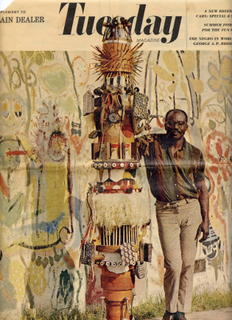 It's only fitting that I begin this tribute to black art, with my Great Uncle, Noah Sylvester Purifoy, on his birthday, August 17.
It's only fitting that I begin this tribute to black art, with my Great Uncle, Noah Sylvester Purifoy, on his birthday, August 17.1n 1965, My Grandma Lewis' brother, Noah (whose art has appeared in the film, "Waiting To Exhale") teamed up with a fellow art colleague Judson Powell,(they were both graphic arts directors of the Watts Arts Festival at the time) and concieved the idea of a sculpure garden around the Watts Towers Art Center, where they were employed as teachers. Then it was learned that the Center would be closing due to a lack of funds. The two artists dug through metal "debris" while the whole community joined their effort, digging for brass and copper.
Knowing that the only value usually placed in the metal, was how much profit could come from it, Noah's thought pattern was thus: "What if these people could look at junk another way-- as a symbol of their being in the world, their being just in relationship to something."
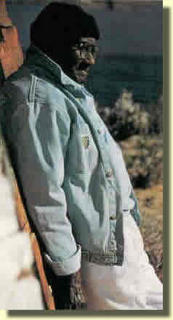
What effect could junk art have on the people who are living right inside of it?"junk" means wasted, unusable material. Transferred to human beings, it means a life of despair, uselessness, hopelessness. The resurrection of people who have been discarded by circumstance. "66 Signs Of Neon" was the result of such thinking, and was the beginning of my uncle's nationally known talent.
"It is not unreasonable to state that everyone is creative...creativity ranks alongside food and shelter as absolute necessities. But art education in most public schools is seen as mere recreation. Yet in reality it is that aspect of education which stimulates the whole process of learning...we recognize that to rediscover himself, each person need not become an artist. But we are certain that, child or adult, whatever one's potential is, it should be given the opportunity to express itself."


On the way to Disneyland, a visitor can make a worth-while trip to "Junkland". The main and only landmark is Watts Towers, some reaching nearly 100 feet in height. It is a bizarre construction in swirling forms of colorful broken tiles, smashed pop bottles, pieces of broken glass and you-name-it embedded in concrete buttresses. It was built over a third of the lifetime of Simon Rodia, an Italian immigrant who was 30 years ahead of the emergence of "junk art." Rodia's Towers put Watts on the map a long time before the Watts riots did.



A former school teacher, Noah Purifoy he had given up "perpetuating an ineffective system" when he saw the number of school dropouts. "Formal education," he charges, "has no connection with the life of a prospective school drop-out and creates no incentive for not dropping out! Kids in Watts drop out because they can't relate to what's going on in the classroom to what they face outside!
"As the curriculum is presently designed, schools present a formalized idea that a certain tool is a must for certain tasks. If these tools are not available to the child, it kills his incentive. We believe that if a child can put any two things together in physical relationship with any means he has at hand, he can learn to put ideas together. If he can do this successfully, he can relate it to his own life."
You can find a 50-foot, three-dimensional mural affixed to the wall of the JFA (Join For The Arts) in Los Angeles, at the JFA's Company Theater (1024 S. Robertson Blvd.)
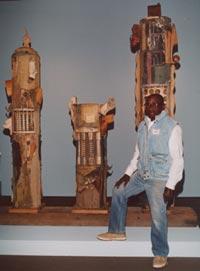
Purifoy moved to the Mojave Desert and spent his remaining years building sculptures. In 1998, he established the Noah Purifoy Foundation to preserve and maintain the 100 pieces of art in his 2.5-acre garden. Purifoy died on March 5 in a fire. When San Bernardino County firefighters found him inside his home, Purifoy was sitting in his wheelchair with third degree burns on over 90 percent of his body; it is believed he fell asleep while smoking. He was 86.
Before his death, he conducted countless workshops, and was a true educator, and hero. His light continues to shine. Goggle Noah Purifoy, and you'll find a vast array of resources, and examples of his legacy.
For more information on my uncle, check out this link:
http://www.museumca.org/global/reso_articles_noah_purifoy.html
Aspects of this article are provided courtesy of The Plain Dealer's Tuesday Magazine, August, 1968.
